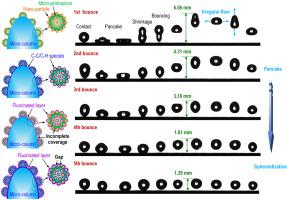Materials Today Physics ( IF 10.0 ) Pub Date : 2022-06-07 , DOI: 10.1016/j.mtphys.2022.100739 Zhichao Ma , Shengteng Zhao , Hairui Du , Jize Liu , Hongwei Zhao , Luquan Ren

|
Realizing proactive anti-icing and efficient thermal management on metal surfaces is still an extreme challenge. However, superhydrophobicity and multiple droplet bouncing capability can increase the probability of deicing. Especially, when the surface is dynamic such as the wings of an aircraft, the multiple droplet bouncing can increase the probability of the droplet passively leaving the solid surface by the forces parallel to the surface. Meanwhile, the droplet forming ability can increase the efficiency of condensation heat dissipation through dropwise condensation rather than film mode. When the surface is applied to absorb the kinetic energy of the impacting droplet, more bounce times can also increase energy collection efficiency based on the collection frequency. To imitate the “lotus effect” with a Cassie-Baxter state, the superhydrophobic surface with a unique quaternary “micro column-micro protrusions-nano particle-fluorinated layer” cross-scale structure is fabricated on Ti alloy through sequential laser ablation, organic adsorption and fluorination treatment. Based on a laser scanning space of 50 μm, although the quaternary structures exhibited crosslinked morphology and irregular micro-column array, subsequent 4 h high-temperature organic adsorption and 0.5 h fluorination treatment realize a contact angle of 164.2°, a slide angle of 7.8° and 5 times droplet bounces. The proposed “mechanical spring” effect induced by the gap between the C–C/C–H layer and the fluorinated layer promotes the multiple bouncing.
中文翻译:

通过激光烧蚀、有机吸附和氟化处理同时实现超疏水性和多液滴弹跳
在金属表面上实现主动防冰和有效的热管理仍然是一项艰巨的挑战。然而,超疏水性和多液滴弹跳能力会增加除冰的可能性。特别是在飞机机翼等动态表面时,多次液滴弹跳会增加液滴在平行于表面的力的作用下被动离开固体表面的概率。同时,液滴形成能力可以通过滴状冷凝而不是薄膜模式来提高冷凝散热效率。当表面用于吸收撞击液滴的动能时,更多的反弹次数也可以根据收集频率提高能量收集效率。为了模仿 Cassie-Baxter 状态的“莲花效应”,通过连续激光烧蚀、有机吸附和氟化处理,在Ti合金上制备出具有独特四元“微柱-微突起-纳米颗粒-氟化层”交叉尺度结构的超疏水表面。基于50 μm的激光扫描空间,虽然四元结构呈现交联形态和不规则的微柱阵列,但随后4 h的高温有机吸附和0.5 h的氟化处理实现了164.2°的接触角,7.8的滑动角° 和 5 次液滴反弹。由 C-C/C-H 层和氟化层之间的间隙引起的所提出的“机械弹簧”效应促进了多重弹跳。











































 京公网安备 11010802027423号
京公网安备 11010802027423号